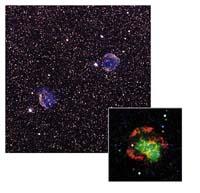Burst young stars

With the Chandra X-ray telescope they discover a new type of supernovae. In a nearby galaxy, the Great Magellanic Cloud, Chandra has collected images of the footprint of the double supernova DEM L238 and DEM L249. His study has revealed a great concentration of iron atoms. Astronomers have concluded that they are remnants of the explosion of white dwarfs.
White dwarfs are the origin of type Ia supernovae. But this double supernova is not type Ia, since the gas that surrounds it is denser and brighter than those of this type.
According to astronomers, the white dwarfs of the new supernova had a greater mass than normal and burst much faster than those of class Ia: It exploded at 100 million years and those in class Ia explode at 1 billion or 1.5 billion years.
Apparently, stars can evolve faster than they imagined, giving astronomers a new footprint to study the creation of the universe.





